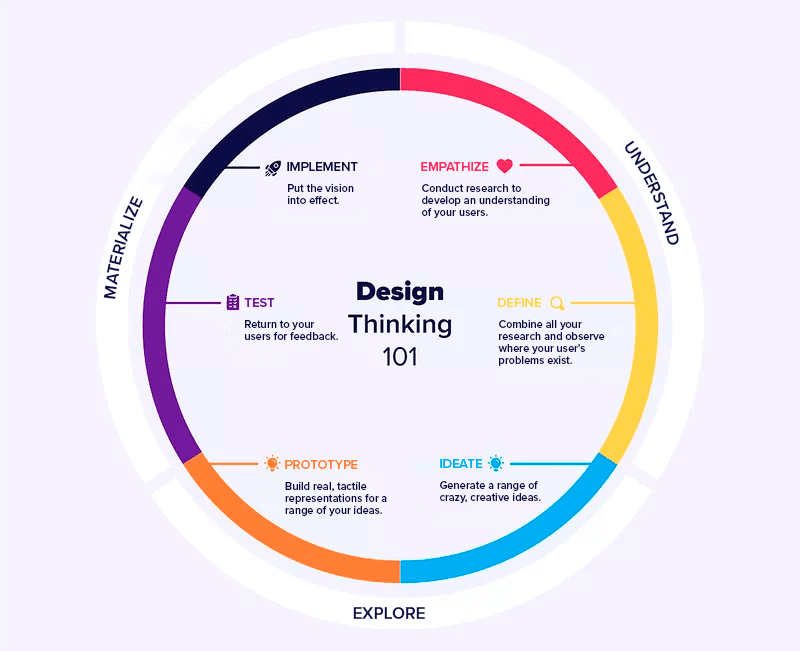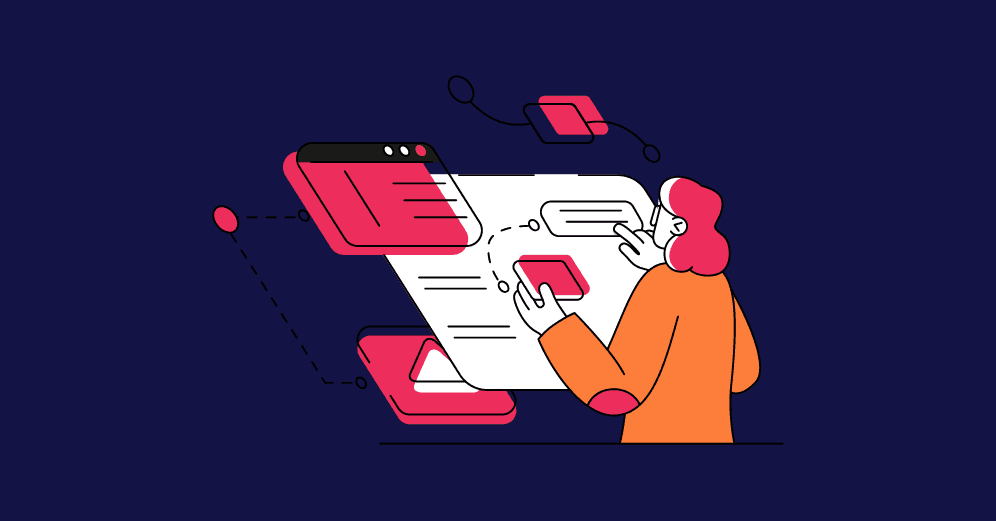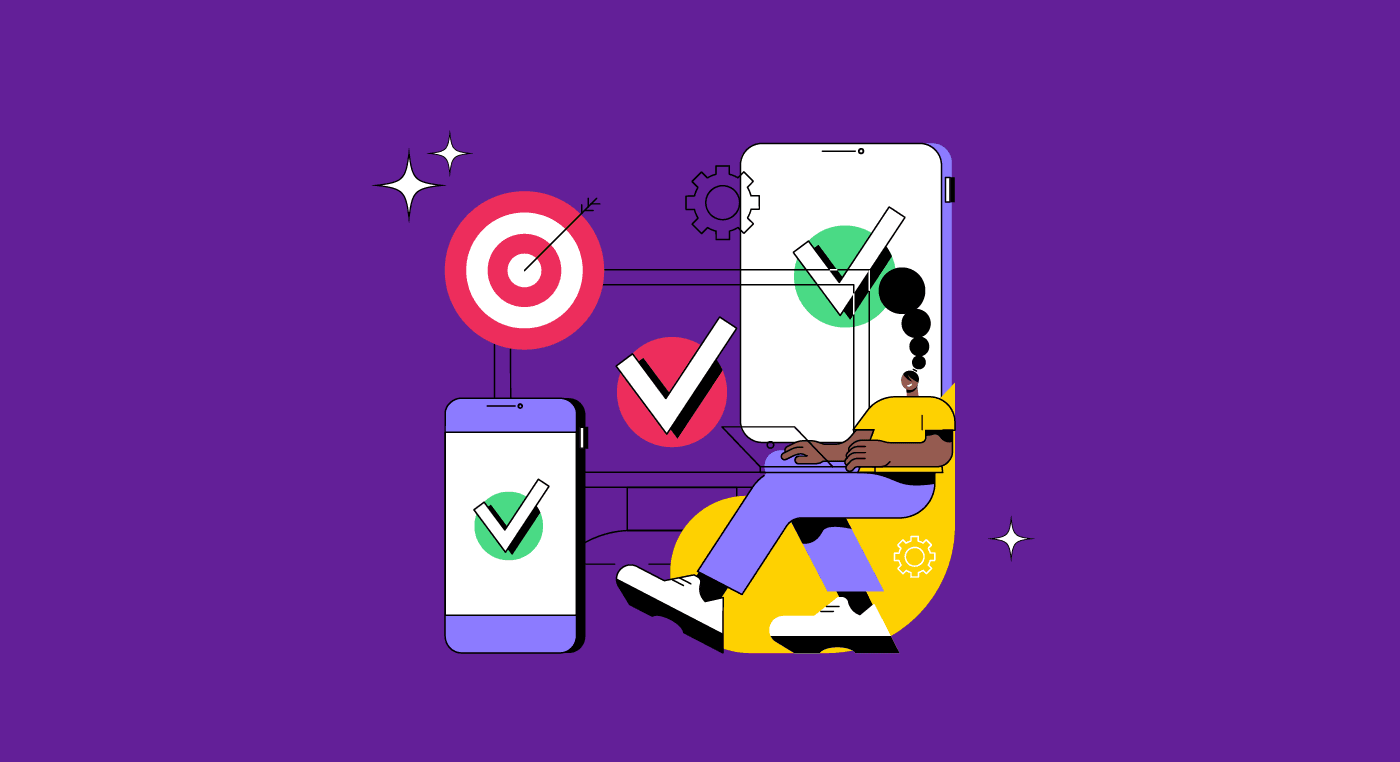What is Design Thinking?
Design Thinking is a concept that was "born" from design, but can be applied in several other areas aiming to solve problems.
This concept is used mainly in the areas of service design and digital product design.
But how?
This approach seeks to meet the users' needs through problem solving.
In this way, people are placed at the center of product development and, in a collective and collaborative way, professionals seek the best strategies to meet the user's needs.
That is why multidisciplinary teamwork is common and primordial for the project development to be done in the best possible way and in a short period of time.
This way of working is the combination of corporate thinking with creative thinking for the same purpose.
In addition, the ideology of Design Thinking assumes that a user-centered approach to problem solving can lead to innovation. In turn, innovation is a factor in standing out and deciding against the competition.
Reading Tip: User-Centered Design: Building Products To Meet User Needs
Design Thinking framework:

Brands like Apple and Nike have been applying Design Thinking for more than 10 years and have been getting positive results ever since. Check it out:
How Apple uses Design Thinking to create innovative and interesting products:
How Nike uses Design Thinking to create products specifically for sportspeople:
Benefits of Design Thinking
Besides the benefits mentioned above, the implementation of Design Thinking in UX Design has other advantages:
- Transforms the way companies develop products, services, and strategies;
- Promotes integration between the team and professionals from other areas;
- Develops new creative strategies in problem solving and user experience improvement;
- Solves problems that are not yet very clear or uncertain;
- It's a flexible process in its execution – it can be performed as much as you need and can be applied in different ways, depending on the team or the company.
Therefore Design Thinking encourages organizations to focus on the users, and thus create human-centered products, services, and processes.
Additionally, Design Thinking can be used in areas other than design, whenever there is a need to find and solve a problem for users.

Reading Tip: Documentation in UX Design: Track Information And Communicate Effortlessly
The Design Thinking Process
The process of applying Design Thinking has a structure represented in a general flow consisting of:
- Understand;
- Explore;
- Materialize.
When detailing this flow, we have the 6 phases of Design Thinking which are:
- Empathize;
- Define;
- Idealize;
- Prototype;
- Test;
- Implement.

Empathize
Empathy can be understood as the ability to put yourself in someone else's shoes. With this in mind, in this stage of the flow, the team must promote surveys that aim to get to know the users better, taking into account what they:
- think
- do
- feel;
- expect from your product, and what problems they wish to solve.
As an example, think of a situation in which the goal is to improve an integration experience for new users. In this phase, it is interesting to talk to several real users and directly observe what they do, how they think, and what they want.
Focus on answering questions such as:
- what is the users' motivation or distress?
- When does the user feel frustrated?
In this step, the goal is to gather enough information so that you can really empathize with your users and their perspectives. And the best way to do this is to put yourself in their shoes.
One of the methodologies used in UX Design to get to know the users of a product and their needs is the design of personas.
Reading Tip: Building Prototypes: What’s The Best Type For Your UX/UI Project
Define
This step is necessary to identify what the users' real problems are. In the definition phase, use the data gathered in the empathy phase to gain information and outline the common ground with user experience.
Is there a common pain spot among many different users?
From this questioning, you can identify unmet user needs. With this, start looking for possibilities of optimization and innovation.
Ideate
In this phase, it is very important to perform a general integration of the teams within the company.
Therefore, gather as many people as possible and think of different ideas and solutions to solve the identified problem.
The ideal is to invite people from different areas and profiles to diversify the ideas.
Brainstorm creative ideas that address the unmet user needs identified in the definition phase. It's important that the members feel free to express and give their opinions. Any idea can be very valuable at this point.
Prototype
After gathering several ideas, it's time to investigate their implementation.
To do this, create real-life representations for a subset of the ideas, that is, a prototype. The goal of this phase is to understand which components of the ideas work and which don’t.
In this phase, you should analyze the impact versus feasibility of the solutions presented in the form of feedback on your prototypes.
How to apply this? If it's a new landing page, design a wireframe and ask your team for feedback. Make the appropriate changes and ask another group of people for their opinion.
Tip: Check out this video of a paper prototype for Wikipedia design proposed by the Bootcamp Master Interface Design course.
Test
After all these steps, changes, and insights, redo the usability test on your users to get feedback.
When it's time to observe, you need to analyze whether the solution
- met the users' real needs?
- Has the way they feel, think, and perform their tasks improved?
Take into account issues beyond solving the problem itself, such as interaction time, ease of navigation for the user, and accessibility.
At this stage, your prototype will already be ready to show to the final customer, but during the development of the project, keep testing to always improve the product.
Reading Tip: Accessibility For Digital Products
Implement
The implementation part is to materialize all the creative work that the team has had so far. Innovation only comes if the vision is executed.
Implementation is crucial. It's also important to note that Design Thinking does not exclude practical design work. As Milton Glaser said:
"There's no such thing as a creative type. As if creative people can just show up and make stuff up. As if it were that easy. I think people need to be reminded that creativity is a verb. A very time-consuming verb. It's about taking an idea in your head and transforming that idea into something real. And that's always going to be a long and difficult process. If you're doing it right, it's going to feel like work." – Milton Glaser
The success of Design Thinking lies in its ability to transform an aspect of the end user's life.
The basis of Design Thinking is about taking action and asking the right questions; it's about simple changes in mindset or ways of asking questions differently – a new way of looking at problems.
More References in Design Thinking
We have several companies and great designers creating very high-quality material about Design Thinking, such as IDEO, Stanford, IBM, and others. I will recommend here some contents, which I suggest you use in your studies, but keep in mind that you can find many other materials on the internet and in books.
1) IBM Enterprise Design Thinking
A video about Design Thinking by IBM:
2) IDEO Design Thinking
- Design Thinking by IDEO;
- IDEO U courses on Design Thinking (I have taken 6 of their courses, and can recommend them).
Super interesting videos from IDEO:
There has been a lot of talk about User-Centered Design lately, and I'm sure you have at least heard about it, right? The interesting thing is that this is the "boom" of the moment, but it is not something new.
Watch this TED talk from 2007, in which David Kelley, founder of IDEO, explains that the future of design is to be human-centered.
3) Book: Change by Design: How Design Thinking Transforms Organizations and Inspires Innovation

I highly recommend you read the book by Tim Brown, former CEO of IDEO, which had a new revised edition released recently.








